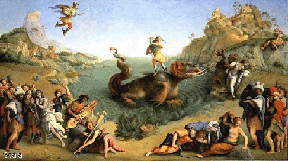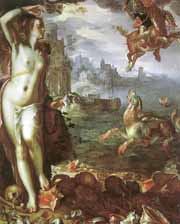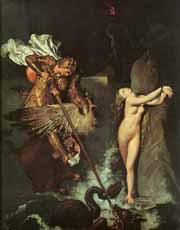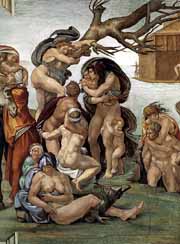Water in Art
Professor Chris Witcombe
WATERS of DESTRUCTION
A Sweet Briar College Learning Resource |
Water in Art
Professor Chris Witcombe
WATERS of DESTRUCTION
|
Too much water can be harmful and life-threatening (you can drown in it). Water in large quantities, such as in the sea, contains a power which can destroy life and good order. Numerous traditions around the world have stories of sea monsters symbolizing the violent threat of the sea. In Babylonian mythology, the sea monster Tiamat threatened to overthrow the gods. In multiheaded sea serpent Leviathan is named in Psalms 74:14. It is killed by God and given as food to the Hebrews in the wilderness. It is the ancestor of the Great Beast which appears later in the Book of Revelations. In some stories, human sacrifice is necessary to propitiate these sea monsters. The sacrificial victim is often young virgin who may, as in the cases of Andromeda and Angelica, be lucky enough to be rescued at the last moment by a male hero.
 (image source: MythNET) Piero di Cosimo Perseus Rescuing Andromeda
 (image source: Carol Gerten) Joachim Wtewael Perseus Rescuing Andromeda, 1611
 (image source: Carol Gerten) Jean-Auguste-Dominique Ingres Roger Saving Angelica, 1839 Some sea monsters, who remained located in a single place, where they prayed upon passing shipping, were represented as female. The most famous are Scylla and Charybdis, who, in Greek mythology, were two immortal and irresistible monsters whom Odysseus encountered in his wanderings, and were later localized in the Strait of Messina (between Italy and Sicily). The mysterious depths of the ocean, and the potentially destructive aspects of the sea, were also personified in female forms, such Mermaids and Sirens, the latter also memorably encountered by Odysseus. Many traditions also contain stories about devastating floods. The Babylonian epic of Gilgamesh tells of an apocalyptic flood, from which was almost certainly derived the Old Testament story of Noah and the flood told in Genesis. The biblical flood is an example of God using water to destroy the wicked and evil-doers.
 (image source: Carol Gerten) Michelangelo The Flood (detail from the Sistine Chapel ceiling), 1508-12
|
|---|
![]()
 CONTENTS
CONTENTS  INTRODUCTION
INTRODUCTION  PURPOSE
PURPOSE  SCHEDULE
SCHEDULE  REQUIREMENTS
REQUIREMENTS  PARTICIPANTS
PARTICIPANTS 
H20 - The Mystery, Art, and Science of Water
Chris Witcombe and Sang Hwang
Sweet Briar College